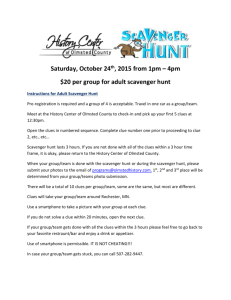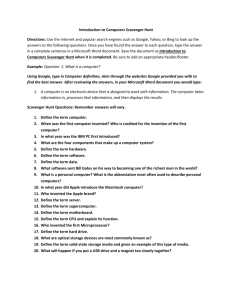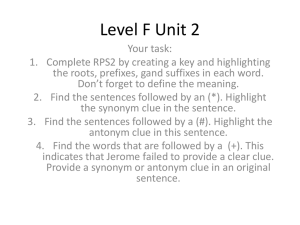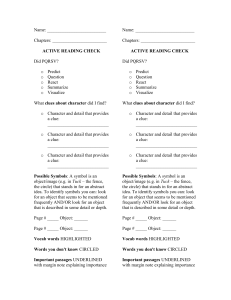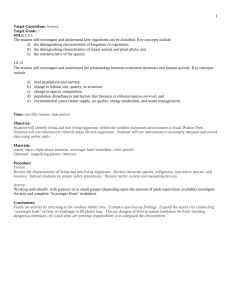Industrial Revolution Scavenger Hunt
advertisement
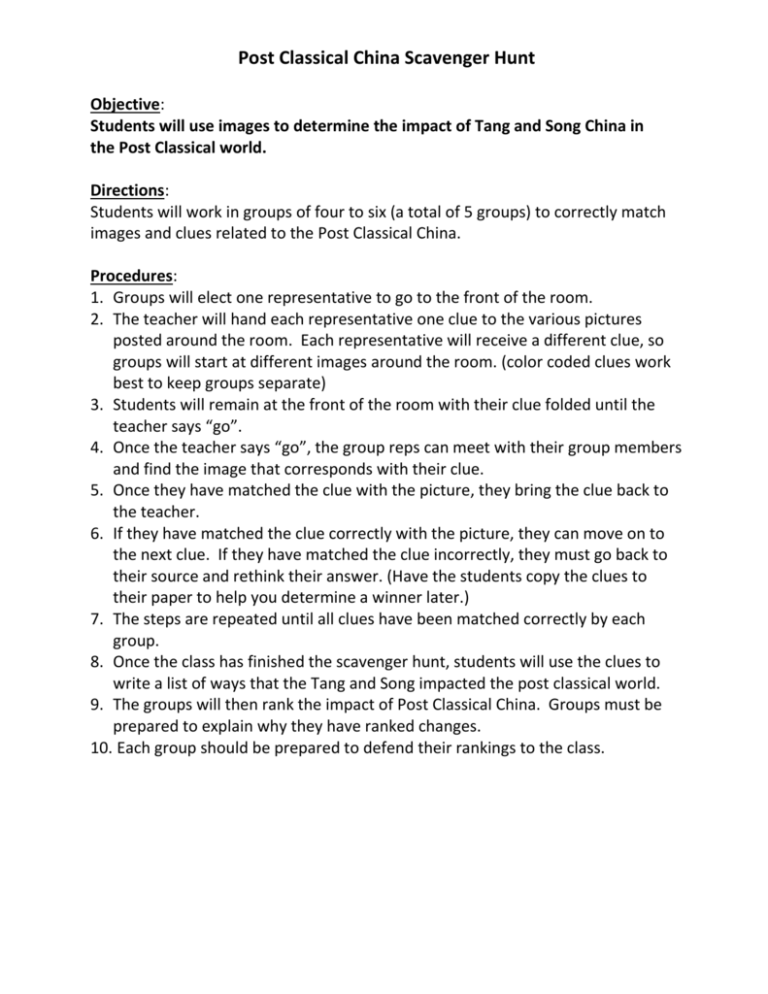
Post Classical China Scavenger Hunt Objective: Students will use images to determine the impact of Tang and Song China in the Post Classical world. Directions: Students will work in groups of four to six (a total of 5 groups) to correctly match images and clues related to the Post Classical China. Procedures: 1. Groups will elect one representative to go to the front of the room. 2. The teacher will hand each representative one clue to the various pictures posted around the room. Each representative will receive a different clue, so groups will start at different images around the room. (color coded clues work best to keep groups separate) 3. Students will remain at the front of the room with their clue folded until the teacher says “go”. 4. Once the teacher says “go”, the group reps can meet with their group members and find the image that corresponds with their clue. 5. Once they have matched the clue with the picture, they bring the clue back to the teacher. 6. If they have matched the clue correctly with the picture, they can move on to the next clue. If they have matched the clue incorrectly, they must go back to their source and rethink their answer. (Have the students copy the clues to their paper to help you determine a winner later.) 7. The steps are repeated until all clues have been matched correctly by each group. 8. Once the class has finished the scavenger hunt, students will use the clues to write a list of ways that the Tang and Song impacted the post classical world. 9. The groups will then rank the impact of Post Classical China. Groups must be prepared to explain why they have ranked changes. 10. Each group should be prepared to defend their rankings to the class. Post Classical China Scavenger Hunt A different kind of beauty? You must be crazy! Alice took one pill to grow and another pill to shrink. You have to write cursive and don't use a mechanical pencil. Give it to me or else…Then, take a bow. So where's the gold? The stuff's pretty amazing, but it's not made of gold. What's that all about? I'm exhausted from shopping. Let's stop at Starbucks. Marco….Polo…Where are you? You could be faster than Michael Phelps with these! New ideas can be threatening to others. There’s a rumbly in my tummy. Variety is the spice of life. We need to plan a family reunion. Can Al get it together? Where did you get that iPhone 5 and all that other stuff? How do you expect to pay for all that? Post Classical China Scavenger Hunt Clue # 1 The Grand Canal was the most elaborate project undertaken during the Sui dynasty, which was one of the world’ s largest waterworks projects before modern times, extending over 1,240 miles. It reached from Hangzhou in the south to the imperial capital of Chang’an in the west. Until railroads came along, the Grand Canal facilitated trade between northern and southern China, particularly to make the abundant supplies of rice and other food crops available to residents of northern regions. By integrating the economies of northern and southern China, it established an economic foundation for political and cultural unity. Post Classical China Scavenger Hunt Clue # 2 During the post-classical period, China expanded to bring Manchuria under imperial authority and forced the Silla Kingdom in Korea to acknowledge the emperor as the supreme ruler. To the south, China conquered part of Vietnam. To the west, they extended Chinese authority as far as the Aral Sea and brought a portion of the high plateau of Tibet under Tang control. In the Song dynasty, Chinese rule was limited to southern China after Tang losses in Central Asia and Manchuria. Post Classical China Scavenger Hunt Clue # 3 The Tang emperors revived the Han dynasty’s practice of maintaining tributary relationships between China and neighboring lands, such as Vietnam and Korea. China was considered to be the Middle Kingdom, a powerful realm with the responsibility to bring order to subordinate lands through a system of tributary relationships. Neighboring lands would and peoples would recognize Chinese emperors as their overlords. As tokens of their subordinate status, envoys from those states would regularly deliver gifts to the court of the Middle Kingdom and in return, the tributary states received confirmation of their authority as well as lavish gifts. This created relations between China and neighboring lands, fostering trade and cultural exchanges as well as diplomatic contacts. Post Classical China Scavenger Hunt Clue # 4 The Tang dynasty relied heavily on a bureaucracy based on merit, as reflected by their performance on civil service examinations. Based on the Han dynasty, Sui and Tang rulers recruited government officials from the ranks of candidates who had progressed through the Confucian education system and had mastered a sophisticated teachings concentrating on the classic works of Chinese literature and philosophy. During the Tang dynasty, officeholders were aristocrats. By the late Tang era, officeholders came largely from the ranks of common families because educational opportunities were widely available. The Confucian educational system and related civil service exams survived until the collapse of the Qing dynasty in 1911. Post Classical China Scavenger Hunt Clue # 5 During the Tang dynasty, the Silk Road expanded to more foreign nations, which helped increased trans-regional trade with other empires and regions. In China, Tang rulers maintained extensive communications networks along the Silk Road, and Tang officials maintained inns, postal stations and stables. If traveling by horse, the Tang court could communicate with the most distant cities in the empire in about eight days. Sometimes, human relay teams of some 9,600 runners provided the Tang court with fresh seafood using the road. Post Classical China Scavenger Hunt Clue # 6 In post-Classical China, tea was introduced from Southeast Asia, and new inventions, such as block printing, mechanical clocks, gunpowder, ceramic figurines, and porcelain (china). The trade of these products helped increased interactions with other empires and regions and spread trade further into China. Moveable type would later spread to Japan and Korea. The Tang revered both horses and camels, figures of which were placed in the burials of the royalty and aristocracy. The Tang and Song would create a golden age of art that occurred in conjunction with the Islamic golden age. Post Classical China Scavenger Hunt Clue # 7 Buddhism spread through trade networks from China, to Korea, Japan, and Vietnam. Buddhism attracted the Chinese partly because of its high standards of morality, its intellect, and its promise of salvation. Buddhists established monastic communities in China and accumulated sizeable estates donated by wealthy converts. They cultivated the lands intensively and stored a portion of their harvests for distribution among local residents for troubled times. Some monasteries engaged in banking activities and others maintained schools. Later, Confucianists would argue that Buddhist monasteries were economically harmful, since they paid not taxes, and others scorned Buddhism as an inferior belief system because of its foreign origins. In addition, they saw the Buddhists as a threat to the role of family and filial piety in Chinese society. Daoists resented Buddhism because it resulted in decreased resources for their followers. Post Classical China Scavenger Hunt Clue # 8 Foot binding involved the tight wrapping of young girls’ feet with strips of cloth that prevented natural growth of the bones and resulted in tiny, malformed, curved feet. Women could not walk easily or naturally. Usually, they needed canes to walk by themselves. Many wealthy families found the feet of their daughters to enhance their attractiveness and gain increased control over the girls’ behavior. It placed women under the tight supervision of their husbands or other male guardians, who managed the women’s affairs in the family. Thus, foot binding also strengthened the dominance of males in Chinese society and can be traced back to Confucian traditions. Post Classical China Scavenger Hunt Clue # 9 . Increased food supplies encouraged the growth of cities. During the Song dynasty, the capital city was moved to Hangzhou in Southern China with more than one million residents. The city boasted hundreds of restaurants, noodle shops, taverns, teahouses, music halls, theaters, clubhouses, gardens, markets, craft shops, and specialty stores, dealing in silk, gems, porcelain, and other goods. China’s total population was over 100 million people, with ten cities having at least 1 million people – the most urbanized land in the world at the time. China was on the verge of the world’s first industrial revolution. Post Classical China Scavenger Hunt Clue # 10 Chinese armies increased agricultural production when they imposed their control over Vietnam. In Vietnam, they encountered strains of fast-ripening rice (champa rice) that enabled cultivators to harvest two crops per year. When introduced to the fertile fields of southern China, the fast-ripening rice quickly resulted in an expanded food supply that would support a growing population and allow extra food for trade. Post Classical China Scavenger Hunt Clue # 11 Because trade grew so rapidly during post-classical China, Chinese merchants developed alternatives to coins that resulted in even more economic growth. They used letters of credit known as “flying paper or money” that enabled merchants to deposit goods or cash at one location and draw the equivalent in cash or goods elsewhere in China. The need for alternatives also led to the invention of paper money. Wealthy merchants printed notes that clients could redeem for merchandise in return for cash deposits. Later printed money even had serial numbers and warnings against printing counterfeit money. The Chinese government also frequently printed currency representing more value than they actually possessed in cash reserves which resulted in the devaluing of Chinese currency. Post Classical China Scavenger Hunt Clue # 12 The Song Chinese were world leaders in shipbuilding. Ships were fastened with iron nails, waterproofed with oils, furnished with watertight bulkheads, driven by canvas and bamboo sails, steered by rudders, and navigated with the aid of the “south-pointing needle” – the magnetic compass. Larger ships sometimes even had small rockets powered by gunpowder. Chinese ships expanded beyond the waters between Japan and the Malya peninsula, ventured into the Indian Ocean and traveled to ports in India, Ceylon, Persia, and east Africa. As they traveled, the Chinese set up merchant communities in Southeast Asia. Those long-distance travels helped spread elements of Chinese naval technology (especially the magnetic compass) that was later used throughout the Indian Ocean as well as well as other Chinese technology and goods through the Indian Ocean trade network.
